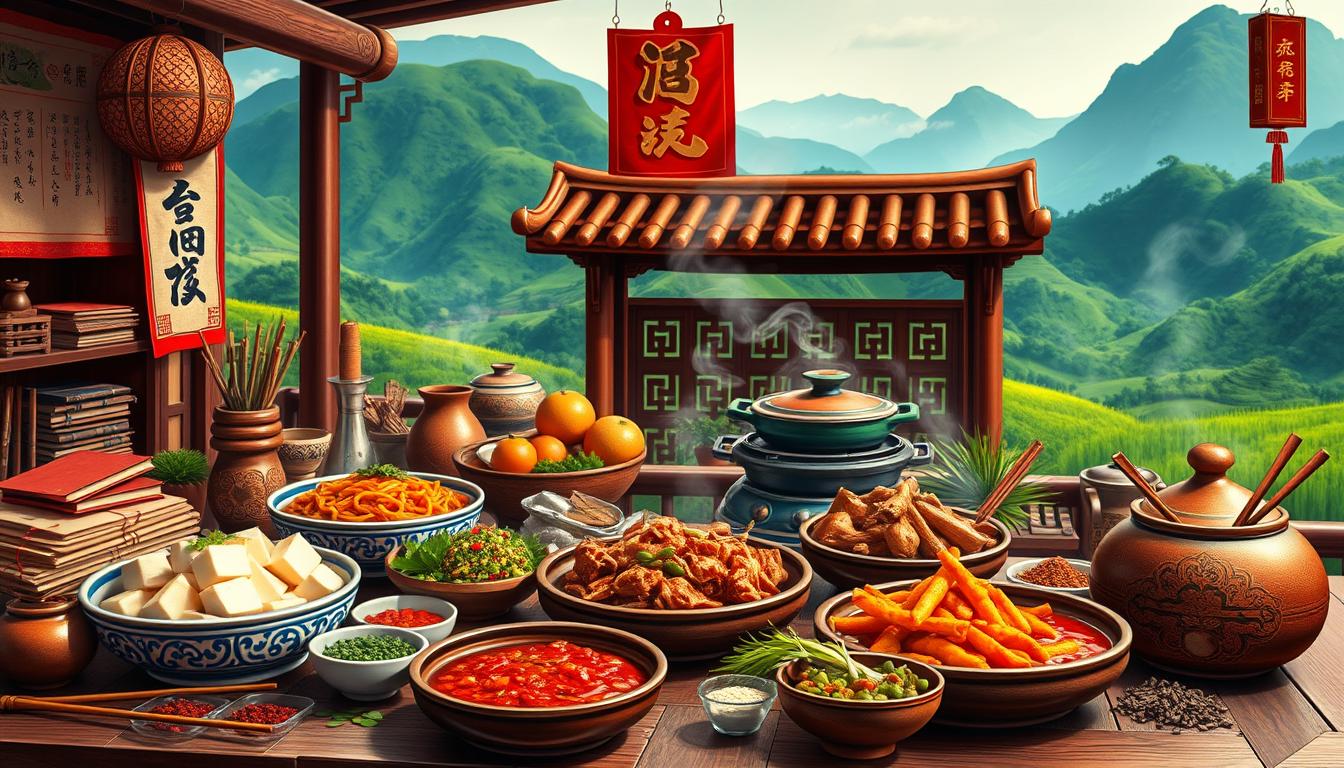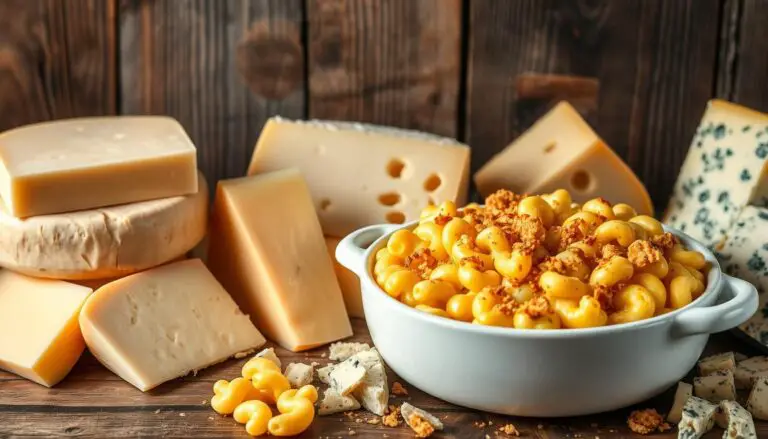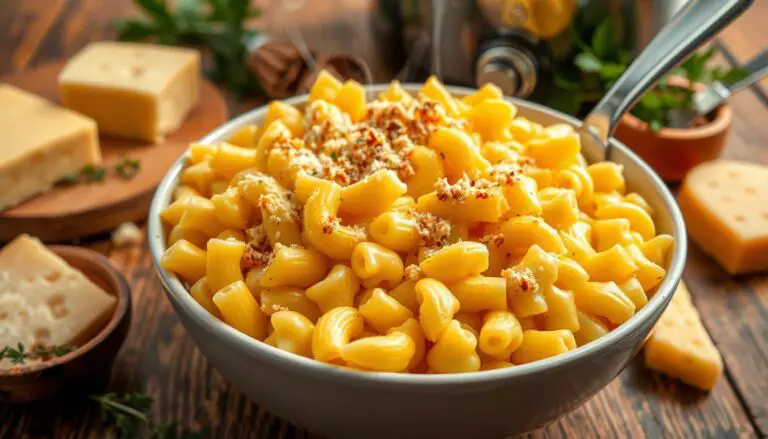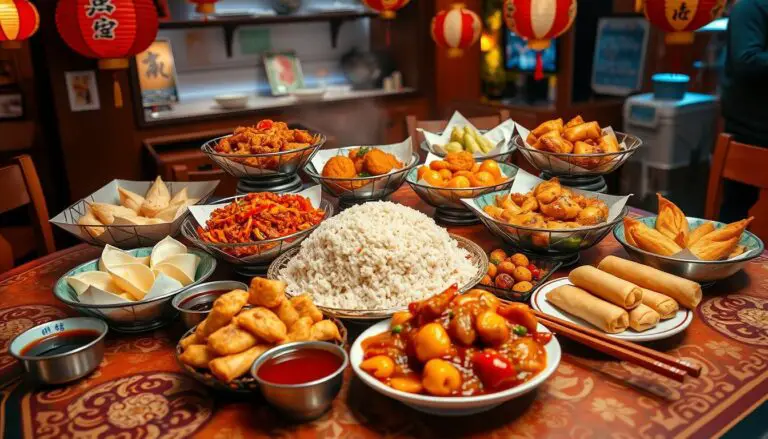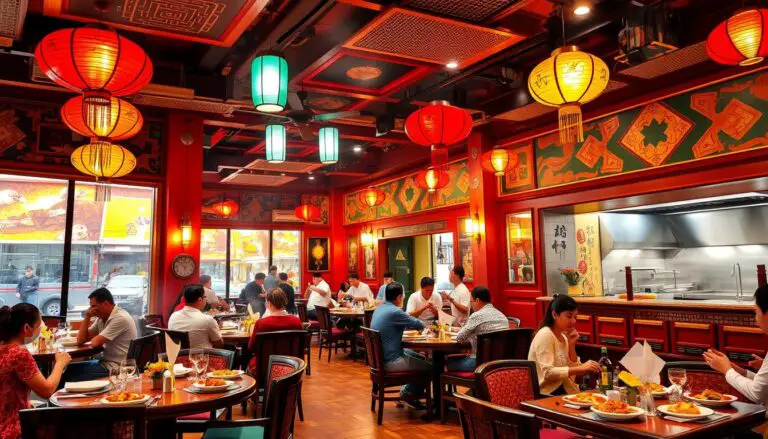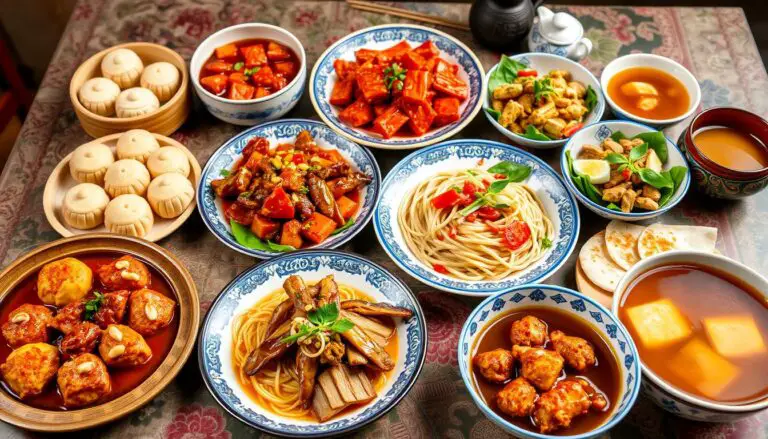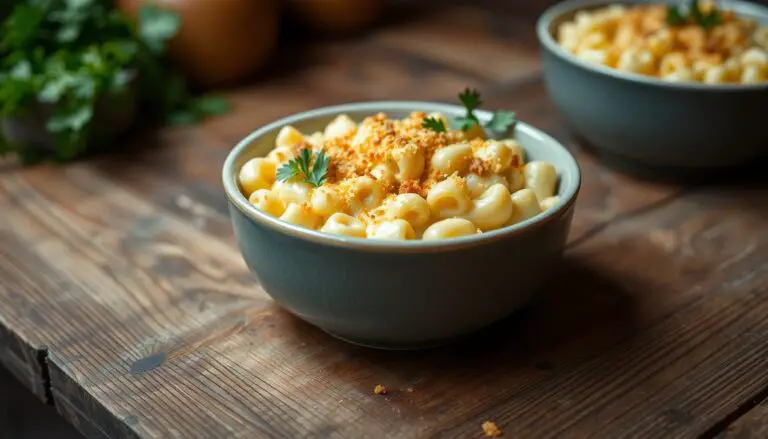Exploring the History of Sichuan Cuisine
What makes Sichuan cuisine so special? It’s not just a local favorite but a global sensation. The history of Sichuan cuisine is long, over 6,000 years, shaped by many factors. It’s known for its bold flavors, especially the ‘ma’ (numbing) and ‘la’ (spiciness) from Sichuan peppercorns and chili peppers.
Dishes like Mapo Tofu and Kung Pao Chicken are famous. Sichuan is in the southwestern provinces of China. It has a population of over 83 million and a unique landscape of mountains and rivers1.
Sichuan cuisine gives us a peek into Chinese cooking’s rich heritage. It shows how flavors blend with local resources and history. Cultural exchanges, from ancient spice routes to today, keep Sichuan cuisine at the top of the culinary world.
Key Takeaways
- Sichuan cuisine holds a history of over 6,000 years, reflecting diverse culinary practices.
- Known for its bold and spicy flavors, it features iconic dishes like Mapo Tofu and Kung Pao Chicken.
- The unique geographical landscape of Sichuan has significantly influenced its culinary traditions.
- Sichuan was designated as a City of Gastronomy by UNESCO, emphasizing its cultural and historical significance.
- The evolution of Sichuan dishes showcases adaptability and integration of new ingredients over time.
The Origins of Sichuan Cuisine
The story of Sichuan cuisine begins in ancient times. It was shaped by early settlers and the unique landscape of the Sichuan Basin. The Sichuan food origins show how agriculture thrived, leading to special cooking methods. These methods are key to Sichuan’s rich culinary heritage.
Early Inhabitants and Culinary Practices
The Shu culture in Sichuan goes back to at least 2000 BCE. This long history shows the people’s early love for cooking2. The first people, like the “Wushan Man,” hunted and foraged for food.
But, it was the start of agriculture that really changed Sichuan’s food scene. It brought new ingredients and ways to cook.
The Role of Natural Resources in Development
Sichuan Province is known for its fertile land and rich resources. The Yangtze River and its tributaries help with irrigation and make the soil better. This leads to crops like rice, beans, and spices that are essential to Sichuan dishes2.
The climate here is perfect for growing strong flavors. Sichuan food is famous for its bold taste, especially with spices3. The area’s natural wealth and diverse people, like the Yi and Tibetans, have made Sichuan’s food even more complex2.
Historical Influences on Sichuan Cuisine
The history of Sichuan cuisine is shaped by migration and new ingredients. In the Ming and Qing dynasties, Sichuan became a mix of flavors. People from places like Hubei brought their cooking ways, adding to the local dishes.
Impact of Migration in the Ming and Qing Dynasties
Migrants in these dynasties changed Sichuan’s cooking. They mixed their cooking styles, creating bold flavors. This mix led to the authentic Sichuan tastes we know today.
Introduction of New World Ingredients
Chili peppers from the New World changed Sichuan food. This change started in the late Ming dynasty. Chili peppers added spice, making Sichuan dishes unique.
The Evolution of Traditional Sichuan Dishes
Sichuan cuisine has changed a lot over time. It now shows a wide range of flavors and cooking styles. These changes reflect its long history and the use of local ingredients and methods.
Classical Dishes Through Historical Periods
Wontons have been around for over 1000 years, starting in northern China. In Sichuan, they are called ‘chāo shǒu’ and are shaped like crossed hands. They were first used in ancestor worship in the Han Dynasty and were known as ‘húntún’ in the Tang Dynasty, filled with minced meat4.
After World War II, wontons became famous worldwide. This shows how Sichuan food has spread globally4.
Culinary Techniques that Shaped Sichuan Food
The way Sichuan cooks has changed a lot. In the past, they just roasted and boiled food. But by the Tang and Song Dynasties, they started using steaming and stir-frying.
Today, Sichuan food is known for its bold flavors. They use garlic, chili peppers, and Sichuan peppercorns. This mix of spicy, sweet, sour, and umami flavors is unique5.
Dishes like Mapo Tofu and Kung Pao Chicken show how classic flavors come together. These dishes highlight the adaptability and richness of Sichuan cuisine5.
Key Characteristics of Sichuan Culinary Heritage
Sichuan cuisine is known for its bold flavors and many substyles. To truly understand it, one must delve into its seven basic flavors.
The Seven Basic Flavors of Sichuan Cuisine
The seven key flavors in Sichuan cooking are sweet, sour, spicy, numbing-spicy (from Sichuan pepper), bitter, fragrant, and salty. These flavors blend together, creating a complex taste in every dish. The addition of chili peppers in the Ming Dynasty added heat and depth to Sichuan food6.
Signature dishes like Mapo Tofu and Kung Pao Chicken show how these flavors work together. They offer a delicious experience for those who try them.
Substyles within Sichuan Culinary Tradition
Sichuan cooking isn’t just one style; it has many, like Chengdu, Chongqing, and Zigong. Each region uses its own ingredients and cooking methods, making Sichuan cuisine rich and varied. For example, Sichuan wontons have a spicy outside and a unique shape, showing the boldness of Sichuan food78.
Historical Documentation of Sichuan Gastronomy
The history of Sichuan cooking is filled with centuries of culinary growth. Early writings give us a peek into what people in Sichuan liked to eat. The “Chronicles of Huayang” from the 4th century shows the area’s love for bold flavors and smells.
Early Literary References to Sichuan Food
Old texts are key to understanding Sichuan’s food history. They talk about the ingredients and ways of cooking used back then. Events like the start of court chefs during emperors’ times show food’s big role in ancient China9.
Modern Scholarly Contributions to Sichuan Cooking History
Today’s research is bringing new insights to Sichuan’s cooking past. Scholars like Lan Yong have changed how we see Sichuan cuisine. They’ve shown how it evolved and its cultural impact over time9.
Studies also talk about the balance in traditional Chinese cooking. Sichuan stands out for its use of hot peppers9 and special cooking ways10.
Regional Variations: Understanding Sichuan Food Origins
Within Sichuan cuisine, different regions offer unique flavors and cooking styles. Chengdu, Chongqing, and Zigong each have their own special touch. This shows the wide range of Sichuan food origins.
Differences Among Chengdu, Chongqing, and Zigong Cuisines
Chengdu is famous for its balanced and elegant tastes, mixing sweetness with a hint of spice. Chongqing, on the other hand, is known for its fiery dishes, especially hot pot. Zigong’s cuisine is rich and savory, thanks to its salt trade history. These styles are part of the five main Sichuan food types, including fancy banquets and street snacks11.
The Influence of Ethnic Minorities on Local Cuisine
The Yi and Tibetan peoples have added to Sichuan’s food scene with their unique ingredients and cooking methods. Their contributions blend well, adding to Sichuan’s diverse flavors. This mix of old traditions and new ideas makes dining in Sichuan a rich experience.
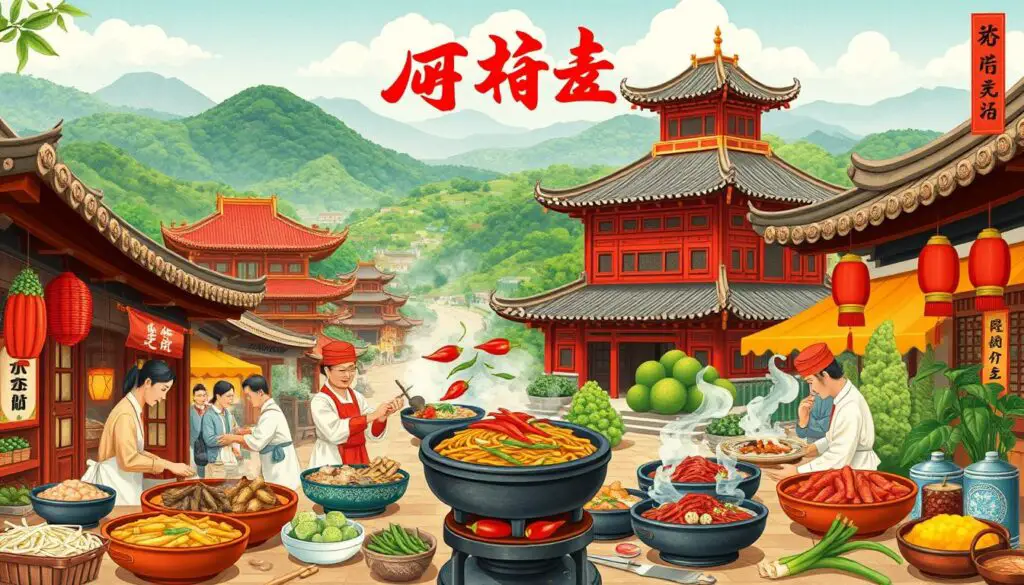
| Region | Key Characteristics | Signature Dishes |
|---|---|---|
| Chengdu | Milder, elegant flavors | Mapo Tofu, Kung Pao Chicken |
| Chongqing | Spicy, bold hot pot | Chongqing Hot Pot |
| Zigong | Strong flavors, salt merchant tradition | Zigong Sweet and Sour Fish |
Modern-Day Interpretations of Sichuan Cuisine
The world of Sichuan cuisine has changed a lot. Chefs now mix old recipes with new ingredients. They keep the unique Sichuan tastes alive. For example, in 2020, Yao Zhao started selling Sichuan pepper oils. This shows how Western people are loving authentic flavors more and more12.
Changes in Ingredients and Flavors
Ingredients and cooking methods have changed a lot in Sichuan cuisine. When the ban on hua jiao was lifted in 2005, real Sichuan taste came back to American kitchens. This sparked a lot of interest in old cooking ways12.
Chef Simone Tong, from Chengdu, showed this change at her Little Tong Noodle Shop in New York. She mixed old dishes with new twists12.
Sichuan Cuisine’s Place in Global Gastronomy
Sichuan cuisine is now known all over the world. Since the 1850s, Chinese food, including Sichuan dishes, has won many fans in the U.S. The California Gold Rush miners loved these flavors. Today, Sichuan is part of the modern Eight Cuisines of China, appealing to many tastes13.
Chefs like Travis Post in Seattle are leading this change. They offer dishes that honor Sichuan and Yunnan traditions. But they also make them easy for more people to enjoy12.
Acknowledgment of Chengdu: City of Gastronomy
UNESCO named Chengdu a City of Gastronomy in 2010. This honor celebrates its rich food history. Chengdu’s cuisine, known as Sichuan gastronomy, is a big part of its culture.
This recognition is part of the UNESCO Creative Cities Network. It looks for cities with great food scenes, active food communities, and use of local ingredients14. Chengdu’s role in Sichuanese cuisine makes it a top food destination worldwide.
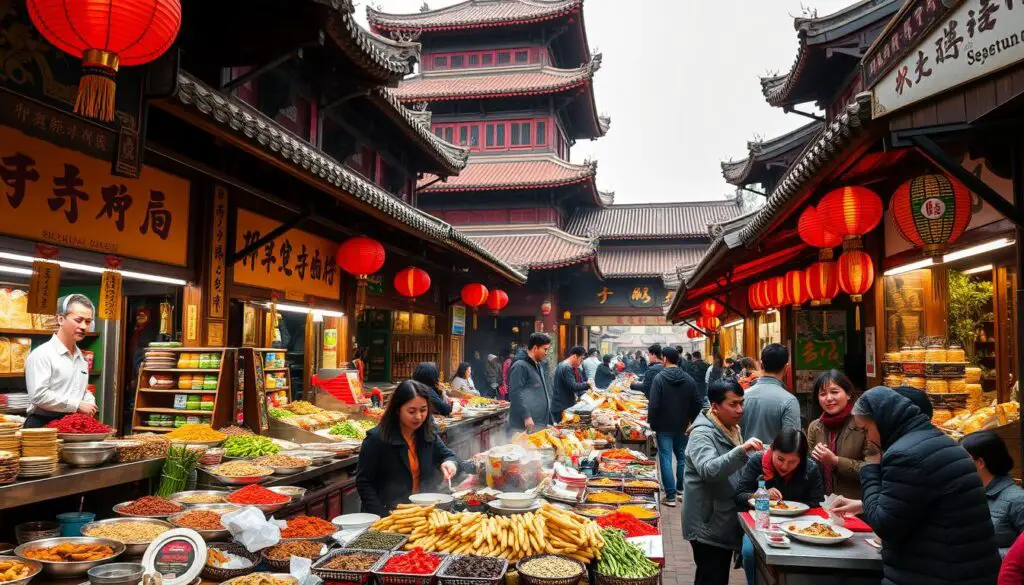
UNESCO Recognition and Its Implications
Chengdu is home to over 14 million people, making it very populous in China15. UNESCO’s nod has helped the city improve its food offerings. It’s now part of tourism plans that show off local culture and food globally.
Chengdu is famous for spicy dishes like Kung Pao Chicken and Mapo Tofu. These dishes highlight Sichuan’s unique flavors15. This move boosts the city’s cultural standing, supports local businesses, and increases community pride in their food traditions.
The Cultural Impact of Sichuan on Food Trends Worldwide
Sichuan cuisine has made a big splash worldwide. Chilies, introduced in the late Ming Dynasty, changed cooking forever16. Today, its spicy and numbing flavors are loved globally.
Mapo tofu, with its unique taste, has caught the world’s eye16. This has led to many cuisines around the world using similar spices and cooking methods. Sichuan’s influence is clear in today’s food trends.
Conclusion
The history of Sichuan cuisine is a rich tapestry of ancient practices, migrations, and diverse ingredients. It has created a unique Sichuan culinary tradition. Known for its bold flavors, Sichuan cuisine delights with a mix of garlic, chili peppers, and Sichuan peppercorns5.
This blend of spices and techniques shows how Sichuan’s cooking has evolved. Yet, it still keeps its true essence. This makes it a standout in Chinese cooking traditions17.
Sichuan dishes are now loved worldwide, showing the cuisine’s adaptability5. Recipes like Mapo Tofu and Kung Pao Chicken are famous for their complex flavors5. These dishes highlight the art of Sichuan cooking.
With many ingredients and techniques, anyone can explore Sichuan cooking at home. It’s a way to connect with this rich culinary heritage. Sharing favorite dishes with others is part of the fun.

